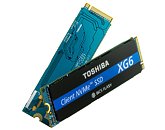Monday, July 23rd 2018

Toshiba Intros XG6 Series M.2 NVMe SSDs
Toshiba today introduced the XG6 series SSDs. Built in the M.2-2280 form-factor with PCI-Express 3.0 x4 interface, the drives take advantage of the NVMe 1.3a protocol, and succeed the XG5 series from 2017. The drives implement Toshiba's new 96-layer 3D TLC NAND flash dubbed BiCS Flash, which went into mass-production in Q1-2018. Available in 256 GB, 512 GB, and 1 TB capacities, the drives offer sequential transfer rates of up to 3,180 MB/s reads, with up to 2,960 MB/s writes. Also on offer are 4K random access transfer rates of up to 355,000 IOPS reads, with up to 365,000 IOPS writes. The drives are expected to be backed by 5-year warranties, when they go on sale at prices competitive with the likes of Samsung's 970 EVO series.


7 Comments on Toshiba Intros XG6 Series M.2 NVMe SSDs
maybe by this time next year they will have a drive that is as fast as the Evo's, but of course by then, Sammy will have drives that are even faster than their current ones, and so the race continues :D
I guess we need (AGAIN) a new type of interface/protocol which is no longer bandwidth limited?? o_Oo_O
Or just extend the number of lines to 8 instead of 4?
I have another question. When PCIe 4.0 and 5.0 arrives, does this mean an automatic doubling increase of maximum bandwidth for NVMe also?
Apparently they are out there.
Samsung PM1725a 6.4TB AIC HHHL PCIe 3.0 x8 NVMe Enterprise Internal SSD
www.vortez.net/articles_pages/samsung_960_pro_raid_review,5.htmlYeah, that's on a dedicated PCIe card not on the M.2 form...
Max bandwidth on AMD and Intel chipsets is about the same even though AMD TR has more PCIe lanes. On the other hand, who cares about max sequential bandwidth when we need performance in random operations where at least in low queues (typical home/office work) single NVMe SSD are faster than anything in RAID.Old article on old chipset, X299 and X399 are scaling up to ~12GB/s on multiple NVMe SSD. In most cases PCIe x16 card is still required as there are no boards with more than 3 M.2 sockets and no Intel boards that support RAID on multiple VMC. Not to mention that Intel requires hardware VROC keys to make it work.